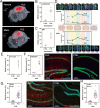Focused ultrasound-mediated brain genome editing
- PMID: 37579143
- PMCID: PMC10450663
- DOI: 10.1073/pnas.2302910120
Focused ultrasound-mediated brain genome editing
Abstract
Gene editing in the brain has been challenging because of the restricted transport imposed by the blood-brain barrier (BBB). Current approaches mainly rely on local injection to bypass the BBB. However, such administration is highly invasive and not amenable to treating certain delicate regions of the brain. We demonstrate a safe and effective gene editing technique by using focused ultrasound (FUS) to transiently open the BBB for the transport of intravenously delivered CRISPR/Cas9 machinery to the brain.
Keywords: CRISPR/Cas9; blood–brain barrier; focused ultrasound; gene delivery; genome editing.
Conflict of interest statement
The authors declare no competing interest.
Figures


Update of
-
Focused ultrasound-mediated brain genome editing.Res Sq [Preprint]. 2023 Jan 20:rs.3.rs-2365576. doi: 10.21203/rs.3.rs-2365576/v1. Res Sq. 2023. Update in: Proc Natl Acad Sci U S A. 2023 Aug 22;120(34):e2302910120. doi: 10.1073/pnas.2302910120. PMID: 36712096 Free PMC article. Updated. Preprint.
References
Publication types
MeSH terms
Grants and funding
LinkOut - more resources
Full Text Sources
Research Materials

